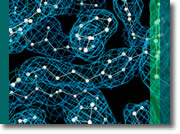| |
 |

PHYSICAL
CHEMISTRY OF ORGANIC SYSTEMS
Coordinator:
Dr. Enrique J. Vasini
Electrochemical processes are of high interest in the search for more sustainable chemical methods and
technology. Indeed, electrons can be regarded as green reagents in electrosynthetic processes. Also,
electrochemical technologies are used in environmental remediation.
Organic Electrochemistry is a multidisciplinary science overlapping the vast fields of organic chemistry,
biochemistry, physical chemistry and electrochemistry.
The electrochemistry of organic compound and the kinetics and mechanism of organic reactions are matters
of vast academic interest as well as of obvious practical value.
Particularly in the case of organic substances, there is an essential connection between the heterogeneous
(electrochemical) charge transfers and the homogeneous (thermal) reaction processes. In fact, the charge
transfer can be considered as a specific activation procedure for organic molecules.
The substrates that were chosen to study are related with fine chemicals intermediates, pharmaceutical
products, pesticides, and a number of other applications. These are:
• 3,4-alkyl or aril-disubstituted 1-oxides and 1,1-dioxides derivatives of 1,2,5-thiadiazole
and their corresponding thiadiazolines (mono-unsaturated thiadiazoles) and thiadiazolidines
(totally saturated thiadiazoles)
• ther nitrogenated heterocycles unsubstituted and subtituted by alkyl or diferent
functional groups, such as derivatives of pyridine, quinoline, phenanthrolines and phenanthroline diones.
Accordingly, the research fields of our project include, for those molecules:
• The charge-transfer processes and the preceding or following homogeneous reactions.
• The related homogeneous thermal reactions
• Their molecular (X-ray diffraction) and electronic (theoretical chemistry) structural details.
• Their electrochemical synthesis and that of their derivatives.
• Their practical uses, as, for example, the corrosion inhibiting capabilities of thiadiazoles.
The interrelated results obtained allow a wide, cross-checked knowledge of the physical and chemical
properties of the substrates.
|
| |
|
Selected
publications in the frame of this project
* "Novel
Synthesis of 3,4,4-Trisubstituted Thiadiazolines from 3,4-Diphenyl-1,2,5-Thiadiazole
1,1-Dioxide. Competition with the Intra-Molecular Aryl-Aryl Cyclization".
M. F. Rozas, O.E. Piro, E.E. Castellano, M. V. Mirífico and E.
J. Vasini. Synthesis, (2002), 2399-2403
* "Crystallographic study and molecular orbital calculations of thiadiazole
derivatives. 2,3,4-diphenyl-1,2,5-thiadiazole 1- oxide".
E.E. Castellano, O.E. Piro, J.A. Caram, M.V. Mirífico, S.L. Aimone,
E.J. Vasini, A.Marquez-Lucero and D. Glossman-Mitnik
Journal of Molecular Structure 604, 195-203 (2002).
* “Reactions of 1,2,5-thiadiazole 1,1-dioxide derivatives with nitrogenated nucleophiles.
Part 1 - Addition of amines and amides to 3,4-diphenyl-1,2,5-thiadiazole
1,1-dioxide".
José Alberto Caram, Silvia Lucía Aimone, María Virginia
Mirífico, Enrique Julio Vasini.
J. Phys. Org. Chem. 16, 220-225, (2003).
* “Partial electrooxidation of nitrogenated heterocycles. Novel synthesis
of 1,10-phenanthroline- 5,6-quinone by electrooxidation of 1,10-phenanthroline”.
M.V. Mirífico, E.L. Svartman, J.A. Caram y E.J. Vasini
Journal of the Electroanalytical Chemistry 566, 7-12 (2004).
* “The addition reaction of diamides to 1,2,5-thiadiazole 1,1-dioxide
derivatives”.
J.A. Caram, M.V. Mirífico, S.L. Aimone, O.E. Piro, E.E. Castellano
y E.J. Vasini
Journal of Physical Organics Chemistry 17, 1091-1098 (2004).
* “Synthesis of an alpha-amino nitrile and a bis alpha -amino nitrile derivative of thiadiazole: reaction mechanism”.
M.V. Mirífico, J.A. Caram, O.E. Piro y E.J. Vasini
Journal of Physics Organical Chemistry 20 (12), 1081-1087 (2007)

|


